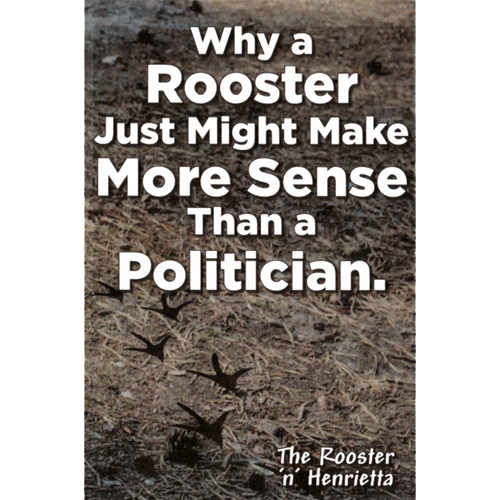Ontario: A Triumph for Technocracy? by Moira C. Egan
- 2015-05-01
- By admin
- Posted in Latest News
Reprinted with permission of the author and the Landowner Magazine.
“Great, said Amanda. Then we’ll use one-third of our capital for my election campaign, one-third for bribes of the election districts, one-third for muddying the reputation of the main opponents and then we’ll keep one-third to live on if things don’t work out.”
The quote is from The 100-Year-Old Man Who Climbed Out The Window and Disappeared, a laugh out loud 2009 novel by Swedish writer Jonas Jonasson. Earlier in the story (one of many in the 100 year long story) we learn that Amanda is considered to be not very bright but is bright enough to know that she isn’t bright. Having come into a fortune through her new husband who is also not very bright, Amanda wonders about what to do with her life.
It’s the 1950’s. She decides to go into politics in Bali where she lives and to become a governor. She creates the Liberal Democratic Communist Freedom Party. Then, by following her plan, she is absurdly successful and wins over 80 percent of the votes while her opponent gets 22 percent. There is a court challenge about the fairness of the election. Amanda handily wins the case by taking the chairman of the court to tea immediately prior to the surprise court decision. As fifteen years of more corruption pass by, opinion polling by her sister’s company shows that Amanda is ever popular with the masses. She retires only when she finds that being governor is no longer fun.
I’ve probably taken a lot of fun out it for you by trying to encapsulate a tale told first by a master of humour. But I wanted to contrast the freedom to govern that Amanda (and even Ontario premiers) possibly could have had in the 50’s and 60’s to how the Premier of Ontario allows the government to be controlled by unelected outside forces in 2015. It is true that in both eras money is at the root of electoral success. In 2015, it comes from wind turbine and other renewable energy companies, from international banks, insurance companies, pharmaceutical and other “health” industries, manufacturers, brokerage houses, oil and gas companies, transnational manufacturers of ‘smart’ stuff, transnational cement companies, developers, private and public unions and others who expect preferential treatment in return for their contributions of money, goods and services.
The funding roots are more tangled than that. Even during the writ period, the activities of Ontario’s non-governmental organizations continue to draw attention to the supposed need for laws, goods and services that will bring a financial return (or something) to their benefactors. And who are their benefactors? Typically, they are the companies, organizations and individuals who are also funding political campaigns.
To add to all of that, little of the legislation that is passed in 2015 will originate in response to demands of real people in Ontario but will reflect the ‘soft’ laws of Agenda 21. Think of things as varied as wind turbines, light bulbs, smart meters, population density, school programs, wild lands and aboriginal affairs. Where could property rights possibly fit in? To add to that, most corporations are also under the thumb of Agenda 21 because it and other instruments of the UN detail what is sustainable in (for example) manufacturing, shipping and trade.
If you have any doubts that the United Nations and its agents are manipulating us and our all-too-willing-to-be-manipulated elected representatives, take a look online at Climate Change: A Plan for Ontario’s Future. Published in February 2015 under the signature of the Minister of the Environment and Climate Change, it includes such drivel as “…will resume conversation among the people of Ontario about climate change… . We plan to engage First Nations and Metis communities from across Ontario in focused conversation to work together to address climate impacts and climate change.”
The discussion paper (quite ridiculously) presents an Ontario climate forecast for 2050. It lists the near-term possibility of a carbon (dioxide) tax and a possible cap-and-trade program. As Scotland Yard and Interpol have discovered in Europe, cap-and-trade is an open invitation to fraud. And the carbon dioxide tax is something that the United Nations wants to collect for its global governance. Of course no mention is made of that.
The document has 39 End Notes. Easily 75 per cent of the information sources listed are international ‘governance’ bodies: the World Bank, the IPCC, World Meteorological Association, UN Secretary, UN programmes, the International Monetary Fund, Global Commission on the Economy, the U.S. Environmental Protection Agency… The few Ontario sources include the 2014 Ontario budget and the 2014 Ministry of Finance Long Term Report on the Economy.
No matter how much evidence we have that there is no evidence of our emissions of carbon dioxide doing anything to create catastrophic global warming or climate change, we know that most of the people behind the sources referenced in the discussion paper insist that climate change is the greatest threat facing us. In a way it is: the threat comes from self-appointed experts who, together with their friends in high places think they have the means to control every aspect of our lives. They’ll keep trying to do so. Even, I’m guessing, if it requires increasing Global Warring. There is an awful lot of money tied up in an imaginary threat.
So how did all this international interference come about over 30 years?
By now, readers of The Landowner are familiar with Agenda 21 which went into effect in 1992. But where did it come from? Who dreamed up the whole idea?
Long before the United Nations was a glint in Stalin’s eye, there were those who imagined a world where the creators of technology would rule. In a fascinating new book entitled Technocracy Rising:The Trojan Horse of Global Transformation, author Patrick Wood traces the history of this thing called technocracy back to August Comte in the 19th century. He then connects dots between early technocracy, its rebirth and today’s sustainable development, Agenda 21 and designs for global governance.
In the 1930’s, Technocracy, Inc. was a popular continental movement in the U.S. and in Canada and, in a somewhat altered style, in Germany.
Technocracy is the science of social engineering, the scientific operation of the entire mechanism to produce and distribute goods and services to the entire population of this continent. For the first time in human history it will be done as a scientific, technical, engineering problem. (page 33) 1937 definition by Technology, Inc.
Some of our fathers and grandfathers might have seen another definition in the preface to a technocracy study course that Ontario groups used in homes, halls and churches: Technocracy is dealing with social phenomena in the widest sense of the word; this includes not only actions of human beings, but also everything which directly or indirectly affects their actions. Consequently, the studies of technocracy embrace practically the whole field of science and industry. Biology, climate, natural resources, and industrial equipment all enter into the social picture.
That’s pretty much the foundation of Agenda 21.
At that time, a man by the name of William Knight, an admirer of Hitler, tried to steer North American technocrats in the direction of the German version. Knight liked the military aspect of it and went so far as to dress himself in a black double breasted suit and to require that underlings dress in uniform grey suits and use the fascist salute. Technocracy in North America fizzled out because Americans didn’t accept a movement that would interfere with national sovereignty, would limit private property rights and would remind them of Hitler’s Nazis. It was “banned in Canada due to accusations of subversive activity”.(page 35)
Technocracy lived on in Germany and the author quotes other historians who say that,
“…Without technocracy, the most barbaric, irrational and backward-looking policies of the Third Reich, including euthanasia, involuntary sterilization, the brutal repression of the socialist movement, ruthless imperialism, ideological warfare on the eastern front, genocide and efforts to create a ‘master race’ would have been impossible.” (page 39)
Technocracy in Germany also disappeared at the end of WW 2.
The rebirth of technocracy in North America came about in the 1970’s. Zbigniew Brzezinski, a Columbia college professor published a book about the 30’s era of technocracy. It caught the imagination of David Rockefeller (whose family donated six blocks of New York real estate to the United Nations.) Rockefeller had for years been enthusiastic about international business. It is no wonder that the following sample from the Brzezinski book appealed to him: “…the nation-state as a fundamental unit of man’s organized life has ceased to be the principal force: International banks and multinational corporations are acting and planning in terms that are far in advance of the political concepts of the nation state.”
In 1972 the two men presented to the elitist Bilderberg Group their idea of forming the Trilateral Commission. It became reality within a year. About 300 people from Europe, North America and Europe received invitations to become commissioners “to improve public understanding of common problems, to support proposals for handling them jointly, and to nurture habits and practices of working together among these regions”.
This book is not the first written by Patrick Wood. In the 70’s, he and Anthony Sutton co-authored Trilaterals Over Washington and Trilaterals Over America. Sutton, a meticulous researcher, had earlier written many books among which are Wall Street and the Rise of Hitler and Wall Street and the Bolshevik Revolution. When he refers to ‘we’ in the following paragraph, I think Patrick Wood is including Sutton:
“The word “commission” was puzzling since it is usually associated with instrumental ties set up by governments. It seemed out of place for a private group unless we could determine that it really was an arm of a government, an unseen government, different from the visible government in Washington. The inclusion of European and Japanese members indicated a global government, rather than a national government. We hoped that the concept of a sub-rosa world government was just wishful thinking on the part of the Trilateral Commissioners. The facts, however, lined up quite pessimistically.” (page 49)
The Trilateral Commission went to lengths to ensure that its influence is felt in elected government. Among Trilateral members, Brzezinski discovered a candidate for president: Jimmy Carter. In Carter’s administration there were no less than 20 Trilateral Commissioners appointed to cabinet and to other top government posts. Every U.S. administration since Carter, Democrat or Republican, has put Trilateral Commissioners in senior posts. Among Canadian Trilateral Commissioners, you’ll find the three main parties represented. Have Trilaterals been appointed to senior Canadian positions? What about right now?
Here, from the web, is a list of current Canadian members of the Trilateral Commission: Scott Brison, Raymond Chretien, Arthur A. DeFehr, Andre Desmarais, Paul Dewar, Wendy Dobson, Peter Godsoe, Bill Graham, Linda Hasenfratz, Colin Kenny, Monique Leroux, Roy MacLaren, John Manley, Heather Munroe-Blum, Jeffrey Simpson, Gordon Smith, Nancy Southern, Ronald Southern, Carole Taylor and Michael Wilson (former finance minister and trade minister in the Agenda 21 adopting Mulroney government). The North America Co-chair of the Trilateral Commission was, until recently, Jim Prentice who is now Premier of Alberta. Those members printed in bold are from Ontario.
To defeat our enemy, we have to know as much as possible about it. Who knows? Some of those who appear to be globalists could turn out to be our friends. I encourage people to read Technocracy Rising because many of us ought to know the information so we can understand what’s going on. I also encourage you to read the 100-Year-Old Man. The laughter is a joy. And the attitude of the hero is inspiring.
Search:
Categories
Archives
- April 2024
- January 2024
- December 2023
- November 2023
- August 2023
- July 2023
- June 2023
- May 2023
- April 2023
- March 2023
- February 2023
- January 2023
- December 2022
- November 2022
- October 2022
- September 2022
- August 2022
- July 2022
- June 2022
- May 2022
- April 2022
- March 2022
- February 2022
- January 2022
- December 2021
- November 2021
- October 2021
- September 2021
- August 2021
- July 2021
- June 2021
- May 2021
- April 2021
- March 2021
- February 2021
- January 2021
- December 2020
- November 2020
- October 2020
- September 2020
- August 2020
- July 2020
- June 2020
- May 2020
- April 2020
- March 2020
- February 2020
- January 2020
- December 2019
- November 2019
- October 2019
- September 2019
- August 2019
- July 2019
- June 2019
- May 2019
- April 2019
- March 2019
- February 2019
- January 2019
- December 2018
- November 2018
- October 2018
- September 2018
- August 2018
- July 2018
- June 2018
- May 2018
- April 2018
- March 2018
- February 2018
- January 2018
- December 2017
- November 2017
- October 2017
- September 2017
- August 2017
- July 2017
- June 2017
- May 2017
- April 2017
- March 2017
- February 2017
- January 2017
- December 2016
- November 2016
- October 2016
- September 2016
- August 2016
- July 2016
- June 2016
- May 2016
- April 2016
- March 2016
- February 2016
- January 2016
- December 2015
- November 2015
- October 2015
- September 2015
- August 2015
- July 2015
- June 2015
- May 2015
- April 2015
- March 2015
- February 2015
- January 2015
- December 2014
- November 2014
- October 2014
- September 2014
- August 2014
- July 2014
- June 2014
- May 2014
- April 2014
- March 2014
- February 2014
- January 2014
- December 2013
- November 2013
- October 2013
- September 2013
- August 2013
- June 2013
- April 2013
- October 2012
- May 2012
- September 2011



